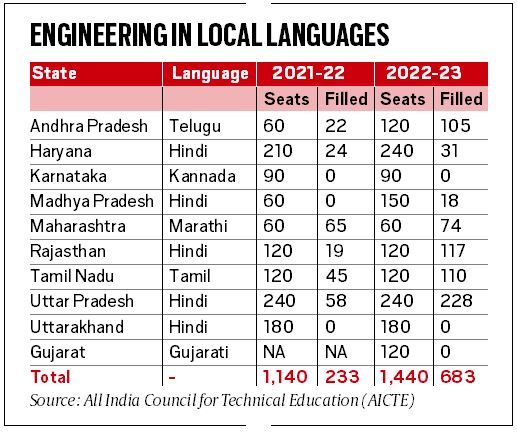Three years ago, the Government launched engineering degree courses in regional languages as part of a new national plan to make technical education more inclusive and not allow lack of English to be a hurdle. Since then, 2,580 seats have been volunteered in local languages by 22 engineering colleges across the country — 18 private, the rest public.
Of the total 25-lakh bank of engineering seats, this is a small fraction but its experience holds larger lessons for the road ahead — indeed, the progress card shows a distinct uptick in local-language programmes in the states of Tamil Nadu, Andhra and Uttar Pradesh.
The Indian Express spoke to officials, teachers, students and recruiters across four states to find what’s behind the uptick and where the challenges lie: from availability of non-English textbooks and language teachers to questions over job prospects. In some colleges, these vernacular programmes have become a popular draw for students from English-medium schools, too, given that it’s easier to get a more “coveted” department.
The Big Picture: Opening the door
In line with the new National Education Policy (NEP 2020), the AICTE approved 1,140 seats for BTech programmes in 11 regional languages — Hindi, Marathi, Tamil, Telugu, Kannada, Gujarati, Malayalam, Bengali, Assamese, Punjabi and Odia — across 18 engineering colleges for the academic year 2021-22. Three of the 18 were government institutes and 15 were private. The move was part of the plan of including native languages as the medium of instruction in higher education to help increase access and promote the “strength, usage, and vibrancy of Indian languages”.
To begin with, engineering courses were offered in only five languages — Hindi, Kannada, Tamil, Telugu and Marathi — in 2021-22. And while colleges in Rajasthan, UP, MP, Haryana and Uttarakhand offered BTech in Hindi, those in Karnataka, Maharashtra, Andhra and Tamil Nadu offered the course in their respective regional language. Of 1,140 seats, the data shows, only 233 seats were filled by these 18 colleges that year.
During the academic year 2022-23, however, the AICTE approved 1,440 seats for engineering in the local language in 22 colleges — four government, 18 private — and almost half or 683 seats were filled with programmes in Hindi, Marathi, Tamil and Telugu.
Among the colleges that recorded a rise was Pune’s Pimpri Chinchwad College of Engineering, a private college which offered admission to 65 students for its four-year computer engineering course in Marathi in 2021-22 against an approved intake of 60. With the AICTE allowing an additional division if needed, its enrollment increased to 74 students in 2022-23.
According to Nilkanth Chopade, deputy director of the college, English-medium students form the majority in the Marathi course. “More than 90 per cent are from an English-medium background. It is a demand and supply situation. For example, there is huge demand for Computer Science and if students fail to get a seat in an English programme, they opt for the Marathi course,” said Chopade.
The Noida Institute of Engineering and Technology (NIET), a private institute in Greater Noida, had only 19 students in the academic year 2021-22. But it filled 68 seats against the approved intake of 60 in the computer science course in Hindi in 2022-23.
NIET director Vinod Kapse credited the “favourable” response to their “multifaceted approach”. “We provide the students with field development programmes and programmes (by online providers like) Coursera so that they are well-equipped for placements,” he said. NIET has also made English language modules provided by the British Council mandatory.
Similarly, Erode Sengunthar Engineering College, a private institute in Tamil Nadu, started a Mechanical Engineering course in Tamil with just 10 students in 2021-22 but managed to fill 49 seats against the approved intake of 60 seats in 2021 and 2022. Enrollment in Computer Science and Engineering in Telugu at the NRI Institute of Technology (NRIIT) in Andhra’s Vijayawada, too, rose from 22 students to 50 against the approved intake of 60 in the same period.
Low numbers in Gujarat, Karnataka
Even as some universities did well, others had trouble getting in even one student.
For instance, courses offered by institutes affiliated to the state-run Gujarat Technical University (GTU) failed to net a single enrollment. A case in point is Gujarat Power Engineering and Research Institute (GPERI), which offered 120 seats in Gujarati in core specialty courses like mechanical, civil, electrical and computer science engineering for the academic year 2022-23. In an effort to “boost” enrollment, GPERI even organised special counselling sessions for students at government schools and diploma colleges, besides those in Adivasi hamlets in and around Mehsana district.
GTU Registrar K N Kher said students have not yet warmed up to the idea. “Many students in the area [Mehsana] are not comfortable with English and we have tried to explain to them that learning will be more effective if done in a regional language. At the diploma level, we have allowed students to study and write their exams in Gujarati… There is a perception among students that if they pursue BTech in Gujarati, they will miss out on placement opportunities,” Kher said.
The “waning” appeal of core specialties may have contributed to the problem, too. “Another reason could be the declining popularity of core branches like mechanical, civil and electrical engineering, even in English,” said Vivek Patel, the head of GPERI’s Mechanical Engineering Department.
Then, there’s the lack of dedicated textbooks and teachers for these courses, prompting some of these colleges to work out indigenous solutions. “Most of the books that we use in classrooms are in English. However, our approach is to gradually make students comfortable in English as they move on. In the first year, we explain the concepts in 75 per cent Telugu and 25 per cent English. This ratio becomes 50:50 in the second year and in the third year most of the curriculum is taught in English. Apart from that, AICTE has developed a tool for translating content in regional languages,” C Naga Bhaskar, the principal of NRIIT, a private institute, said.
The college has adopted a similar approach to the recruitment of teachers. “We asked them whether they would be comfortable teaching in Telugu as well as English. Only those who were comfortable in both were hired for this programme. We have hired nine teachers so far for our regional language programme,” Bhaskar said.
The principal, however, acknowledged that “most of the parents are still worried if their child will be able to get a job at the end of this programme”. “I assure them that the recruiters are focused on skill rather than the medium of instruction in the classroom,” Bhaskar said.
Another challenge, he said, is for students who wish to pursue higher studies abroad. “They may face difficulties because, according to the eligibility criteria of several foreign universities, students must have studied their bachelors in the English medium. Currently, there are 10-15 per cent students who wish to study abroad and I have communicated this issue to AICTE,” Bhaskar said.
Language can’t be barrier: AICTE
The AICTE, meanwhile, is hopeful of the tide turning gradually.
Rajive Kumar, AICTE member secretary, said, “We have started faculty development programmes in Indian languages. We have given students options (to choose regional language courses). Books are being translated in regional languages and efforts are being made to equip teachers to teach in regional languages. This multi-dimensional approach will surely help increase interest among students, but it will happen gradually. This is not likely to show results in just two years.”
Kumar said, “When we spoke to industry partners, no one expressed their unwillingness to hire students who had studied in Indian languages. It is our mindset that makes us think the industry will not hire us.”
‘Not a major constraint’ for recruiters
Asked about a recruiter’s perspective, R C Bhargava, chairman, Maruti Suzuki India, said, “An HR person would be more adept at answering this question, but common sense would dictate that if a company prefers to conduct its work in a particular language, then it would want to hire engineers who understand and can read that language. Wouldn’t it be a handicap if the engineer cannot speak the language fluently to interact with his colleagues? At Maruti, we deal with the Japanese. The Japanese have learned English. So our employees are usually fluent in English and Japanese.”
Naushad Forbes, co-chairman Forbes Marshall, a leading steam engineering and control instrumentation firm, said, “In second and third tier engineering colleges, students are usually taught in regional languages but take tests in English, essentially practicing bilingual education. Offering engineering degrees in regional languages isn’t a significant change for them. From the market’s perspective, although English is essential for most engineering jobs, it’s something young people can easily learn. I don’t view this shift as a major constraint.”
In India, “being bilingual is best”, said Manish Sabharwal, co-founder of TeamLease Services, one of the country’s leading HR consultants.
“Being bilingual (English and a native language) improves labour mobility and there is a wage premium for being bilingual. In tech, especially the software sector, knowing English language matters given that 99 per cent of the work happens in English. While it’s a good thing that the education system is being inclusive (with the introduction of tech programmes in native tongue), people should also realise that there is optionality to multilingualism,” Sabharwal said.
“A majority of our recruiters are based in India, and their emphasis is on skills over medium of instruction. Nevertheless, we have dedicated lectures to make students proficient in business English communication, which will improve employability,” said Sansar Singh Chauhan, head of Computer Science Engineering at GL Bajaj Institute of Technology and Management in UP’s Noida, which started its Hindi programme in 2021-22.
Credit: Source link




